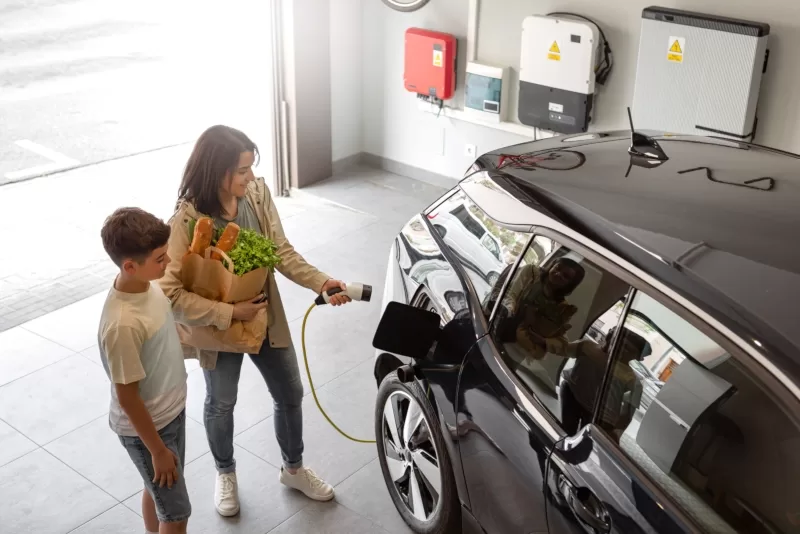Here’s What Your Home Needs to Welcome Your New Vehicle.
So, you’re planning to make the leap into electric vehicle (EV) ownership. Congratulations! Whether it’s the quiet ride, zero tailpipe emissions or freedom from fossil-fuel dependency, owning an EV is a major step toward a cleaner, smarter future.
But before you settle into the smooth rhythm of EV life, make sure your home is ready to support it, and here’s some good news for Northern California residents:
If you live in Marin or Sonoma counties, there are rebates available to help cover the cost of installing a home EV charger. Additionally, many local utilities and PEV (plug-in electric vehicle) readiness programs provide financial incentives for homeowners to improve their electrical infrastructure and install Level 2 charging infrastructure. That means you may be able to power up your EV at home for less than you think.
1. Upgrade Your Charging Setup
You may already know most EVs come with a standard Level 1 charger that plugs into a regular 120-volt outlet. The downside? It can take over 24 hours to fully charge your vehicle. A better long-term solution is the Level 2 charger, which uses a 240-volt outlet, similar to what your clothes dryer or kitchen oven uses.
What to expect:
- Faster charging (typically 4–8 hours for a full charge)
- Professional installation required
- May require a permit depending on your location
Local tip: Check with PG&E, MCE Clean Energy, or Sonoma Clean Power—they offer rebates or incentives that may cover a portion of your EV charger purchase and installation.
2. Check Your Electrical Panel
Before installing a Level 2 charger, your electrician will need to inspect your electrical panel. If your home is older or has limited capacity, you may need to upgrade your panel from 100 amps to 200 amps. This ensures your EV charger won’t overload your system. This is especially important if you have other high-power appliances or plan to go fully electric in the future.
3. Designate a Charging Zone
Where will you charge, in your garage, carport, or driveway? No matter the location, make sure:
- The charging spot is close enough to your panel to keep installation costs down.
- You have safe, convenient access to the charger.
- Outdoor setups need to be weatherproof, and cords should be secured to prevent tripping hazards.
4. Optimize Wi-Fi for Smart Charging
Many modern chargers come with Wi-Fi capabilities, allowing you to schedule charging during off-peak hours, monitor usage, or even pause charging remotely. If your charger is in the garage, you might need to boost your home’s Wi-Fi signal to maintain a solid connection. In some cases, you might choose to create a separate Wi-Fi network for it.
5. Take Advantage of Rebates and Incentives
If you skipped the lead-in paragraphs, don’t miss this! Homeowners in Marin and Sonoma counties may qualify for:
- EV charger rebates through local utility providers
- Panel upgrade assistance
- Time-of-use rate plans that lower charging costs during off-peak hours
Start by checking the Sonoma Clean Power GridSavvy Program or MCE’s EV resources, and contact your local energy provider for the latest offers (see below).
Tips Before You Install
- Confirm eligibility with your utility before purchasing equipment.
- Choose an approved charger to ensure you qualify for rebates.
- Hire a licensed electrician to meet rebate requirements.
- Save all receipts and documentation for applications and tax filings.
- Apply early—many rebate programs are first-come, first-served and have limited funds.
To save you some time, here’s a deeper dive into rebates.
PG&E Residential Charging Solutions Rebate
If you’re a PG&E customer (which most homeowners in Marin and Sonoma are), you may be eligible for a rebate of up to $500 for installing an approved Level 2 charger at home.
- Standard Rebate: Up to 50% of the cost of the charger (max $500).
- Rebate Plus: Income-qualified customers can receive up to 100% reimbursement.
Requirements:
- Must be a residential PG&E electric customer
- Charger must be on PG&E’s approved list
- Installation by a licensed California electrician is required
- Equipment must be purchased after November 17, 2023
Learn more: PG&E EV Rebate Program
Sonoma Clean Power GridSavvy Rewards
Sonoma County residents who are customers of Sonoma Clean Power (SCP) can participate in the GridSavvy Rewards program, which offers incentives for enrolling a smart EV charger.
- Earn ongoing bill credits by allowing SCP to manage your EV charging times.
- You can either bring your own smart charger or buy a discounted one through SCP.
Learn more: SCP GridSavvy Rewards
BAAQMD Clean Cars for All
The Bay Area Air Quality Management District’s Clean Cars for All program offers up to $9,500 for low-to-moderate income households to retire older, high-emission vehicles. The grant can also help pay for a home EV charger and installation.
- Must live in an eligible zip code
- Funds can be applied toward EV purchase and Level 2 charging equipment
Program page: Clean Cars for All
Federal EV Charger Tax Credit
Thanks to the Inflation Reduction Act, you may also qualify for a federal tax credit for EV charger installation:
- Credit Amount: 30% of the cost, up to $1,000
- Eligibility: Your property must be in a low-income or non-urban area (many parts of Sonoma County qualify)
IRS Info: Alternative Fuel Refueling Property Credit
Bonus: Future-Proof Your Home
Thinking ahead? Consider these extras:
- Solar panels to power your EV with clean energy
- Battery backup systems for resilience during outages
- Load management systems to avoid a full panel upgrade if space is tight
Installing an EV charger at home is usually a one-time investment that pays off in convenience, savings, and peace of mind. With a little planning and support from local rebate programs, you’ll be ready to plug in and power up from the comfort of your own home.


